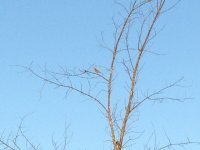playinwood
Member
Sorry for no pictures my camera is on the fritz and he's a ittle shy but Ill try describing as I'm curious.
On our small farm I saw a scarlet tanager an oriole, bobolinks . kingbirds, tree swallows,blue jays ravens and a thrush today.
I also have a bird outside our window for the life I have no idea what it is but has been around for a few years.
"He" is quite loud with many different voices and sings in the evening and early morning , a larger bird with a long (split?) tail. I also believe a light (white) chest and darker body.He never really shows himself.
I'm thinking mockingbird but Ive never seen one before and I'm seeking more experienced birders for a clue.
Many thanks Jeff
On our small farm I saw a scarlet tanager an oriole, bobolinks . kingbirds, tree swallows,blue jays ravens and a thrush today.
I also have a bird outside our window for the life I have no idea what it is but has been around for a few years.
"He" is quite loud with many different voices and sings in the evening and early morning , a larger bird with a long (split?) tail. I also believe a light (white) chest and darker body.He never really shows himself.
I'm thinking mockingbird but Ive never seen one before and I'm seeking more experienced birders for a clue.
Many thanks Jeff





